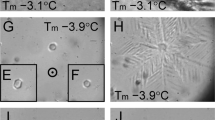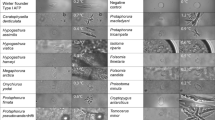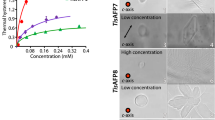Abstract
Antifreeze proteins (AFP) inhibit ice growth by surface adsorption that results in a depression of the freezing point below the melting point. The maximum level of this thermal hysteresis shown by the four structurally unrelated fish AFP is approximately 1.5°C. In contrast, hemolymph and crude extracts from insects can have 5° to 10°C of thermal hysteresis. Based on the isolation, cloning, and expression of a thermal hysteresis protein (THP) from spruce budworm (Choristoneura fumiferana), the vastly greater activity is attributable to a 9 kDa protein. This novel, threonine- and cysteine-rich THP has striking effects on ice crystal morphology, both before and during freezing. It is also 10 to 30 times more active than any known fish AFP, offering the prospect of superior antifreeze properties in cryoprotective applications.
This is a preview of subscription content, access via your institution
Access options
Subscribe to this journal
Receive 12 print issues and online access
$209.00 per year
only $17.42 per issue
Buy this article
- Purchase on Springer Link
- Instant access to full article PDF
Prices may be subject to local taxes which are calculated during checkout
Similar content being viewed by others
References
Hew, C.L. and Yang, D.S. 1992. Protein interaction with ice. Eur. J. Biochem. 203: 33–42.
Ramsey, A.J. 1964. The rectal complex of the mealworm Tenebrio molitor L. Philos. Trans. R. Soc. Ser. B 248: 279–314.
Duman, J.G. and Horwath, K. 1983. The role of hemolymph proteins in the cold tolerance of animals. Annu. Rev. Physiol. 45: 261–270.
Sanders, C.J. 1991. Biology of North American spruce budworms, pp. 579–620 in Tortricid Pests, their Biology, Natural Enemies and Control, van der Geest, L.P.S. and Evenhuis, H.H. (eds.) Elsevier Science Publishers B.V., Amsterdam, the Netherlands.
Man, E.-N. and Bauce, E. 1993. Physiological changes and cold hardiness of spruce budworm larvae, Choristoneura fumiferana, during pre-diapause and diapause development under laboratory conditions. Can. Ent. 125: 1043–1053.
Hew, C.L., Kao, M.H., So, Y.S., and Lim, K.P. 1983. Presence of cystine-containing antifreeze proteins in the spruce budworm, Choristoneura fumiferana. Can. J. Zool. 61: 2324–2328.
Chao, H., DeLuca, C.I., and Davies, P.L. 1995. Mixing antifreeze protein types changes ice crystal morphology without affecting antifreeze activity. FEBS Lett. 357: 183–186.
von Heijne, G. 1986. A new method for predicting signal sequence cleavage sites. Nucl. Acids Res. 14: 4683–4690.
Graham, L.A., Liou, Y.-C., Walker, V.K., and Davies, P.L. 1997. Hyperactive antifreeze protein from beetles. Nature. In press.
Wishart, D.S., Boyko, R.F., Willard, L., Richards, F.M., and Sykes, B.D. 1994. SEQSEE: A comprehensive program suite for protein sequence analysis. Comput. Appl. Biosci. 10: 121–132.
Sönnichsen, F.D., Sykes, B.D., and Davies, P.L. 1995. Comparative modeling of the three-dimensional structure of type II antifreeze protein. Protein Sci. 4: 460–471.
Jorgensen, H., Mori, M., Matsui, H., Kanaoka, M., Yanagi, H., Yabusaki, Y., and Kikuzono, Y. 1993. Molecular dynamics simulation of winter flounder antifreeze protein variants in solution: correlation between side chain spacing and ice lattice. Protein Eng. 6: 19–27.
Knight, C.A., Cheng, C.C., and DeVries, A.L. 1991. Adsorption of α-helical antifreeze peptides on specific ice crystal surface planes. Biophys. J. 59: 409–418.
Sicheri, F. and Yang, D.S.C. 1995. Ice-binding structure and mechanism of an antifreeze protein from winter flounder. Nature 375: 427–431.
Wen, D. and Laursen, R.A. 1992. A model for binding of an antifreeze polypeptide to ice. Biophys. J. 63: 1659–1662.
Chao, H., Sönnichsen, F.D., DeLuca, C.I., Sykes, B.D., and Davies, P.L. 1994. Structure-function relationship in the globular type III antifreeze protein: Identification of a cluster of surface residues required for binding to ice. Protein Sci. 3: 1760–1769.
Jia, Z., DeLuca, C.I., Chao, H., and Davies, P.L. 1996. Structural basis for the binding of a globular antifreeze protein to ice. Nature 384: 285–288.
Sönnichsen, F.D., DeLuca, C.I., Davies, P.L., and Sykes, B.D. 1996. Refined solution structure of Type III antifreeze protein: Hydrophobic groups may be involved in the energetics of the protein-ice interaction. Structure 4: 1325–1337.
Duman, J.G., Xu, L., Neven, L.G., Tursman, D., and Wu, D.W. 1991. Hemolymph proteins involved in insect sub-zero temperature tolerance: Ice nucleator and antifreeze proteins. In Insects at Low Temperatures. Lee, R.E. and Denlinger, D.L. (eds.) Chapman and Hall, New York.
Zachariassen, K.E. 1985. Physiology of cold tolerance in insects. Physiol. Rev. 65: 779–832.
Raymond, J.A., and DeVries, A.L. 1977. Adsorption inhibition as a mechanism of freezing resistance in polar fishes. Proc. Natl. Acad. Sci. USA 74: 2589–2593.
Chakrabarty, A. and Hew, C.L. 1991. The effect of enhanced α-helicity on the activity of a winter flounder antifreeze polypeptide. Eur. J. Biochem. 202: 1057–1063.
DeLuca, C.I., Chao, H., Sönnichsen, F.D., Sykes, B.D., and Davies, P.L. 1996. Effect of Type III antifreeze protein dilution and mutation on the growth inhibition of ice. Biophys. J. 71: 2346–2355.
Fourney, R.M., Joshi, S.B., Kao, M.H., and Hew, C.L. 1984. Heterogeneity of antifreeze polypeptides from the Newfoundland winter flounder, Pseudopleuronectes americanus. Can. J. Zool. 62: 28–33.
Li, X.M., Trinh, K.Y., Hew, C.L., Buettner, B., Baenziger, J., and Davies, P.L. 1985. Structure of an antifreeze polypeptide and its precursor from the ocean pout, Macrozoarces americanus. J. Biol. Chem. 260: 12904–12909.
Ng, N.F., Trinh, K.Y., and Hew, C.L. 1986. Structure of an antifreeze polypeptide precursor from the sea raven, Hemitripterus americanus. J. Biol. Chem. 261: 15690–15695.
Lane, W.S., Galat, A., Harding, M.W., and Schreiber, S.L. 1991. Complete amino acid sequence of the FK506 and rapamycin binding protein, FKBP, isolated from calf thymus. J. Prot. Chem. 10: 151–160.
Altschul, S.F., Gish, W., Miller, W., Myers, E.W., and Lipman, D.J. 1990. Basic local alignment search tool. J. Mol. Biol. 215: 403–410.
Author information
Authors and Affiliations
Rights and permissions
About this article
Cite this article
Tyshenko, M., Doucet, D., Davies, P. et al. The antifreeze potential of the spruce budworm thermal hysteresis protein. Nat Biotechnol 15, 887–890 (1997). https://doi.org/10.1038/nbt0997-887
Received:
Accepted:
Issue Date:
DOI: https://doi.org/10.1038/nbt0997-887
This article is cited by
-
Design and Analysis of a Mutant form of the Ice-Binding Protein from Choristoneura fumiferana
The Protein Journal (2022)
-
Characterization of microbial antifreeze protein with intermediate activity suggests that a bound-water network is essential for hyperactivity
Scientific Reports (2021)
-
Antifreeze protein complements cryoprotective dehydration in the freeze-avoiding springtail Megaphorura arctica
Scientific Reports (2020)
-
De novo transcriptome analysis of an Arctic microalga, Chlamydomonas sp.
Genes & Genomics (2013)
-
Ice recrystallization inhibition mediated by a nuclear-expressed and -secreted recombinant ice-binding protein in the microalga Chlamydomonas reinhardtii
Applied Microbiology and Biotechnology (2013)



